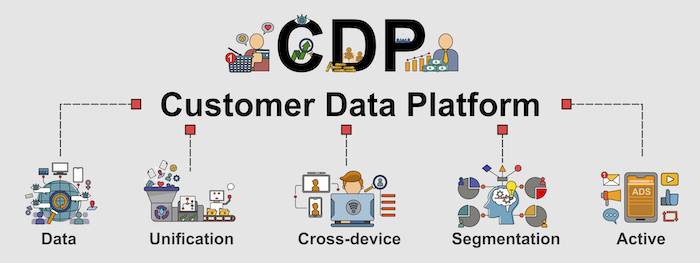A customer data platform (CDP) enables companies to store and manage customer data from a number of different sources inside a single repository. When a company unifies customer data from multiple sources using a CDP it allows the business to gain a more comprehensive understanding of customer behavior and preferences.
What Does a Customer Data Platform (CDP) Do?
To achieve a high level of personalization, companies collect customer data from various data sources such as website engagement, marketing campaigns and customer service interactions. They then integrate all of that information into a CDP as a single, central repository. The company then manages and maintains this data for accuracy and completeness, thereby allowing companies to segment and classify their customers based on characteristics such as demographics and behavior.
Here are some specific examples of what a well-managed CDP can help companies learn about their customers.
- Customer segmentation: A CDP can help businesses segment their customers based on various features like demographics, behavior or interests. This can help companies create more targeted and effective marketing campaigns as well as personalized customer experiences.
- Customer journey mapping: A CDP can help businesses understand their customers’ buying journey. This includes information about what motivates them to make a purchase, what channels they prefer to use and what obstacles they face.
- Product recommendations: A CDP can help businesses identify patterns in their customers' behavior and preferences. This can enable companies to offer more targeted product recommendations and cross-promotion opportunities.
How Does a Customer Data Platform Work?

A customer data platform works by collecting, integrating and managing customer data from different sources to create a centralized and unified view of the customers. We can break down how a CDP works using the following steps.
1. Data Collection
A CDP collects customer data from various data sources including customer behavior on their website, customer response to marketing campaigns and customer service interactions.
2. Data Management
After data collection, the platform standardizes the data and integrates into the CDP. This process involves mapping and transforming data from different sources into a common format that can be used to create a unified customer profile. For this, various techniques such as data cleansing, de-duplication, and database normalization ensure the data is accurate, consistent and normalized.
3. Data Segmentation
The CDP enables companies to segment their customers into groups based on different characteristics. These characteristics can include demographic, behavioral or person-specific properties like preferences and interests.
4. Personalization
By using the customer data stored in the CDP and segmenting customers’ data into groups, companies can better understand their customers and make targeted offers, such as personalized marketing messages and product recommendations.
5. Data Activation
Through a CDP, an organization can use customer information to activate their marketing channels and systems, including email marketing, ad networks and analytics tools.
Benefits of CDPs
- Centralized and Unified Customer Data: A CDP creates a single, centralized repository of customer data. This gives companies a complete overview of their customers.
- Improved Customer Understanding: Using a CDP, a company can segment or classify their customers into groups based on various criteria like demographics, consumer behavior and other characteristics. As a result, CDPs enable a company to gain a better understanding of its customers.
- Personalized Experiences: With a CDP, companies can offer their customers personalized experiences, such as targeted marketing messages and recommendations for products and services.
- Improved Data Accuracy: A CDP manages and maintains customer data, which helps ensure its accuracy and completeness.
- Increased Marketing Efficiency: A CDP automates the process of collecting and managing customer data, thereby saving employee time and effort across the board. At the same time, a CDP allows companies to spend more time creating and performing targeted and personalized marketing campaigns.
Customer Data Platform (CDP) vs. Customer Relationship Management (CRM)
Customer data platforms (CDP) and customer relationship management (CRM) are both software solutions that organizations can use to manage their customer data. However, there are some differences between these solutions.
We use CRMs to manage interactions with customers and potential customers throughout the customer lifecycle — from lead generation or acquisition to post-sale support and ongoing relationships. A CRM usually has features for managing customer data like contact information, sales history and customer service interactions.
On the other hand, CDP is a type of software that collects, integrates and manages customer data from multiple sources with the purpose of establishing a unified customer profile. CDP often incorporates advanced data analytics and segmentation features, which are used to optimize marketing and customer experiences.
In summary, CRM focuses on managing customer interactions while CDPs focus on unifying customer data from multiple sources to create a comprehensive view of each customer.
Examples of CDPs
There are numerous examples of customer data platforms available on the market, each with its own unique features and capabilities. Here are some of the most popular ones.





